#The Alan Price Combo
Text

Meet the Kitchen Kens!
That's right! Your favorite life-sized playthings are available in packs of two now! That means you can get two Kens for the price of one, and boy are these guys worth the money!
Are you tired of slaving away in the kitchen all night just to end up with a mediocre meal? Do you wish you had one big strong man to cook you the finest dinners and another to clean up the mess? Well, look no further than Chef Ken and Dishwasher Alan! We promise these guys will meet your every need in the kitchen, and they'll do it all with a smile on their handsome faces.
These men belong in the kitchen. Ken knows his place is at the stovetop, spatula in hand, and Alan will always be waiting at the sink with a sponge and a can-do attitude. It doesn't matter if it's a midnight snack or a midmorning brunch, they'll be primed and ready for your order. The knowledge of several five-star chefs has been programmed into Ken's head, and Alan is trained to scrub your dishes until you can see your face sparkling in its reflection!
Buy Ken and Alan now! You'll never find two men more dedicated to serving you in the kitchen, but stayed tuned...
This is just the first set in our new line of Ken and Alan combos. Get ready for these pals to take on even more fun and useful careers...
121 notes
·
View notes
Text
Hilton Valentine icons 💚
Photos by my friend @the-alan-price-combo




#The Animals#The Animals icons#hilton valentine icons#hilton valentine#english musicians#british invasion#1960 music
2 notes
·
View notes
Text
The Encounter(s) (1958-59) -
All Sections | Next Section
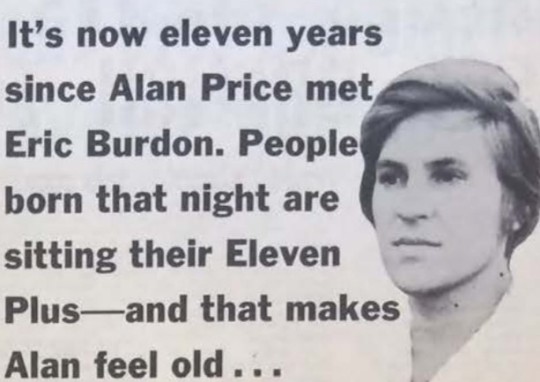
“And talking of age, I feel old. Do you know it’s 11 years since I met Eric Burdon? People who were born that night are now sitting their eleven plus…” - Alan Price, Melody Maker, February 1st, 1969 (p. 5).
January/February, 1958 -
Alright, we’re starting out perfectly: no precise dates. I know, I know… if I knew them, believe me, I’d include them and make it a national holiday! At the very least, Alan and Eric seem to be on the same page about the setting in which they became acquainted with one another; though, these moments seem to be spread over several encounters. As such, I’ll be describing them in the order I believe they happened. Hilariously enough, it’s thanks to that Melody Maker quote above that I at least know the year/month they met, since it hasn’t been outright stated in any books or Eric’s autobiographies, besides in Sean Egan’s Animal Tracks: The Story of the Animals, which implies a first meeting in March of 1959. However… working-backwards from that Melody Maker issue implies this encounter happened a year earlier, and I’m a little more inclined to believe Alan here since he was saying this when it was fresh in his mind, a decade after they met. So thanks, Alan, for randomly ruminating to a newspaper about meeting Eric Burdon for the first time with literally no context whatsoever. It’s almost like you think about him a lot.
Anyway, a little about the lads before they met one another: Eric Burdon was born on May 11th, 1941, in Newcastle’s suburb of Walker. He was raised in a very traditional lower-working-class family, turned onto blues music at a very early age; the genre was always at the back of his mind, even when he eventually enrolled himself at the Newcastle Art College. It was around this time (~’56 and ‘57) that he began singing on the side, and also met the Animals’ future drummer, John Steel. Like many of his rockstar-contemporaries, art college didn’t entirely work out for Eric, but it really highlighted his artistic inclinations and had a profound impact on the kinds of people Eric found himself surrounded by; musically adept and similarly enamored with the blues and rock & roll.

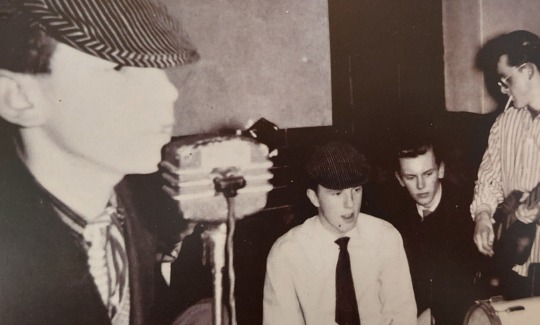
Young Eric and also John Steel, circa 1957/58!
Alan Price was born on April 19th, 1942; south of Newcastle in County Durham. He lost his father to an industrial accident at age six, stayed at his grandmother’s during a good portion of his childhood, and was stricken with yellow jaundice when he was ten/eleven. Because of how much time he had to spend alone while his mother and grandmother were at work, and inspired by his older brother, who was taking piano lessons, Alan taught himself how to play the piano. Alan’s style leaned towards more jazzy, lounge-esque music, as well as early rock & roll, with Jerry Lee Lewis being one of his largest inspirations early on. He eventually attended the Jarrow Grammar School and, throughout his teenage years, participated in several skiffle groups on the side.
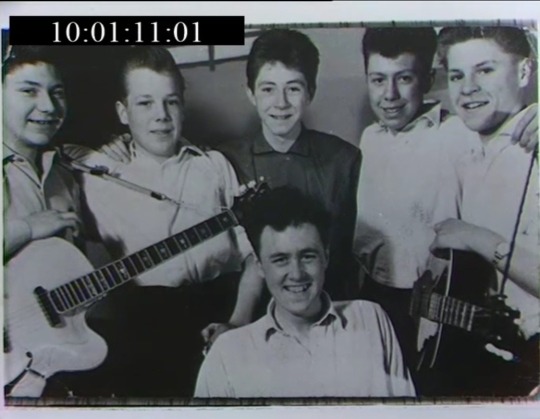
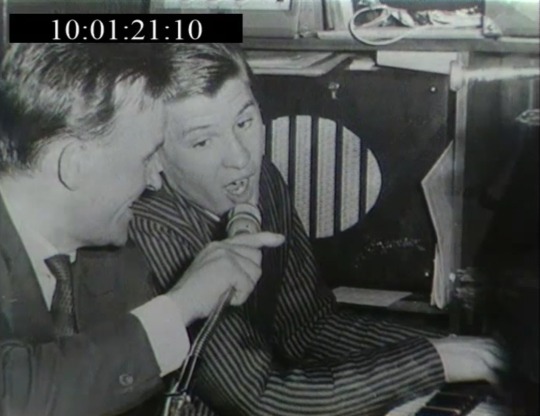
Young Alan in one of his early skiffle groups and on piano!
For a couple of years, Eric and Alan were, unbeknownst to each of them, orbiting one another. At the time of meeting, Eric and John were in a small, college-based blues group called the Pagans, while Alan was in a local skiffle group known as the Thomas Hedley Combo (Thomas? Frank? I’ve heard him called both names in recollections… but I’m going with Thomas). Interestingly, Alan didn’t play piano much in this group, being stuck on the bass for most of his performances, much to his chagrin.
As mentioned before, their timeline of “meeting” is a bit odd yet relatively consistent, so I will be listing the order that I believe events transpired. Starting with a passage from Eric, talking about meeting Alan Price at the Newcastle Methodist Church Hall late one winter evening…
“...I was standing there underneath the lamppost, eating my fish and chips which were swimming in vinegar when I heard that riff, that Ray Charles riff, being played at an intense volume coming from that Methodist church hall. I couldn’t believe my ears. It certainly wasn’t the record. I knew it wasn’t a recording, but the movement was correct, it was real. I made a bee-line for the doors, paid a shilling entrance fee and stood there in the middle of an almost empty dance floor. At the end of the hall there was a small combo playing, the Thomas Hedley Combo - bass, piano, and guitar. I stood there, munching on my chips, listening fascinated. This was the basis of the band that I had been looking for. After they’d finished ‘What’d I Say’, to my amazement, Thomas Hedley got up, walked away from the piano down to the end of the hall to order himself a soda pop, and the bass player, who turned out to be Alan Price, put down the bass and got on the piano himself, and launched into a medley of Jerry Lee Lewis songs. He played even better than Thomas Hedley and I knew from that moment on that this was one musician I’d have to get together with.
“...Alan Price and the guitar player, whose name I can’t recall, just hung out in the background and watched myself and Thomas talking.
“Before I left I got a chance to talk to Alan Price. I told him that I felt that he was much better on piano than on bass. He grunted his thanks and walked away.” - Eric Burdon, I Used to Be an Animal, but I’m All Right Now, 1986 (p. 21).
At the time, Alan would’ve been fifteen and Eric sixteen.
Alan doesn’t seem to have an account of this particular meeting, or perhaps he’s just combining it with an encounter they had later, but it’s probably because, at this point, he was very reserved. Maybe he wasn’t aware of Eric’s own presence in local music groups at this point and thought he was just some random bloke paying him a compliment. Of course, it still meant a lot to have his skills validated (if his little bout of fluster at the end is anything to go by…), but he probably wasn’t aware of just how life-changing Eric’s presence in his life would be at this point, or if he would even see him again…
March, 1959(?) -
Yes, alas, we have no exact dates again. Apologies, this is going to be a trend. Also, as I mentioned before, this particular meeting was stated to be in March of ‘59 by Sean Egan, even if I personally believe that this happened the year prior. Oh, well, this is one of the few actual dates we have on record for their early years, so I’ll take what I can get.
This occurred at the Headlam Street Church Hall, in the suburb of Byker in Newcastle. It was a small gig, and one both the Pagans and the Thomas Hedley Combo were playing for.
“...We went on to play the middle spot and this guy from this other band came up after we’d played a couple of numbers and said, ‘Can I sit in?’ It was a church piano, upright and out-of-tune piano. He’s been playing rhythm guitar in [Thomas Hedley]’s band but he just sat down at the piano and started playing amazing boogie. We thought ‘Whoa! He’s gotta join us.’ Simple as that. We just made that important decision and said, ‘Do you wanna come and be with us?’” - John Steel, Animal Tracks: The Story of the Animals, 2012 (p. 23).
“I walked in, and we were second on, ‘cause we were the big name, you see… I think. And there were these fellas with striped county caps and dark glasses, and lookin’ very cool. But they were playing very good music, stuff I hadn’t heard before. I mean, it was really good blues music and it wasn’t jazz. And it was Eric Burdon, with Johnny Steel, with a college group, and they called themselves the Pagans. And I was very impressed.
“You know… we were all very nervous in those days. If you met anybody that played any different music… I mean, you were really frightened. There wasn’t… jazz and rock & roll and the American records weren’t played on television and radio, and you didn’t have a real insight as to how good music was. And anybody different, you were frightened of.
[Interviewer: “Did you get to talk to Eric Burdon?”]
“Yes… he said, ‘Come and join me, and we’ll make a lot of money’...
“...I was really impressed , and he asked me, actually, in the interval, if I would play with them on piano, which I never had the chance so I leapt at it. And he came over to Jarrow, where we practiced in the pub, ‘cause we could get a drink when we were fifteen. And he said, ‘Listen, I’m with the college, and we’re going to make a lot of money. We’ve got a lot of gigs in the college circuit.’ …because he was at the Newcastle Art College. And we played twice in six months. But it was nice to meet them, and they started me on the right road.” - Alan Price, Northerners, 1975
I absolutely love how Alan describes everything here, from his initial fears to especially the way he describes Eric. Offering him the chance to play on the piano in their band instantly swayed Alan, as it was something Alan rarely was able to do in Hedley’s group - only when Hedley himself wasn’t playing it. Eric recognized Alan’s potential immediately and encouraged him to chase it, be it with their group or on his own. And that validation must’ve been wonderful to receive, not just from someone he was “impressed” by, but especially after playing second fiddle to someone who he was convinced was better than him. Eric saw right through that.
John’s account is a little more general, with a lot of “we” included in there, but he was a passive observer of this relationship and it’s pretty obvious that Alan and Eric’s initial conversations went a lot deeper than, “Hey, you want to join?”, especially with Alan’s detailed account. John’s outsider perspective is interesting, because he seems to have it in his mind that Alan and Eric did not get along or have anything in common besides mutual respect for one another’s talents, which is a point of view I personally disagree with, but some of the insight he later gives sheds a lot of light on their early bonding, as well as Alan’s general attitude. I’ll have more John-thoughts throughout this analysis, but I figured I’d mention some here, since he’s one of the few voices we have from the beginning.
So, how did this relationship take off?
All Sections | Next Section
6 notes
·
View notes
Text
A fanart of The Dark Animals drawing by my friend @the-alan-price-combo

#The Animals#The Animals Series#villain fanart#The New Adventures of The Animals Series#The Animals Series villains#The Animals villains#The New Adventures of The Animals Series villains#dark eric burdon#eric burdon#dark hilton valentine#hilton valentine#alan price#dark alan price#dark john steel#john steel#dark chas chandler#chas chandler
1 note
·
View note
Text
The Dark Animals fanart by @the-alan-price-combo





#The Dark Animals#villain fanart#The Animals villains#the new adventures of the animals series#The New Adventures of The Animals Series villains#dark eric burdon#dark alan price#dark john steel#dark chas chandler#dark hilton valentine#The Animals Series#The Animals Series villains#dark dave rowberry
1 note
·
View note
Photo

SING SANG SUNG #SingSangSung The Animals est un groupe de rock fondé en 1962 à Newcastle-upon-Tyne, Angleterre. 1/ USIQUE The Animals - House of the Rising Sun (1964) (La Maison Du Soleil Levant) https://youtu.be/4-43lLKaqBQ Alan Price, John Steel, Bryan Chandler et Hilton Valentine jouent chaque fin de semaine dans un petit orchestre de jazz baptisé Alan Price Combo du nom du chanteur. Rapidement, ils sont rejoints par Eric Burdon qui fait évoluer le groupe dans une direction qui correspond plus à ses aspirations musicales. Leur sauvagerie sur scène, où se dégage notamment la voix âpre et puissante de Burdon leur vaut rapidement le sobriquet d'Animals, qui devient leur nom officiel à partir de 1963. Leur premier album 'The Animals' sort en 1964. 2/ MUSIQUE «Don't Let Me Be Misunderstood» par The Animals (Fais En Sorte Que Je Ne Sois Pas Incompris) https://youtu.be/Bw7RTUEZMyg En 1966, suite à des remaniements infructueux, Burdon dissout The Animals. En 1976, le groupe initial se reforme à l'initiative de Chas Chandler sous le nom The Original Animals. En 1983, le groupe original est à nouveau réuni de façon éphémère, une tournée mondiale s'en suivit avant que le groupe ne se sépare une fois de plus. En 2005, le groupe est formé d'Eric Burdon (chant), Eric McFadden (guitare), Red Young (claviers), Paula O'Rourke (Basse) et Wally Ingram (batterie). https://www.facebook.com/groups/1466860133344387/?ref=share_group_link https://www.instagram.com/p/Cm819yfsV1W/?igshid=NGJjMDIxMWI=
0 notes
Photo

The Alan Price Rhythm and Blues Combo
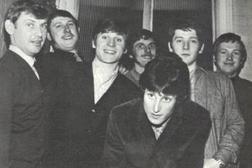
The Alan Price Set
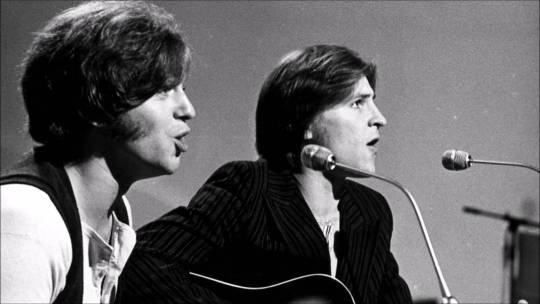
Price and Fame
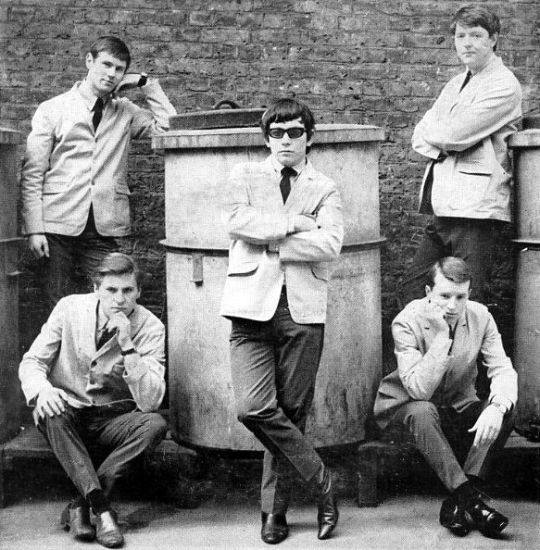
The Animals
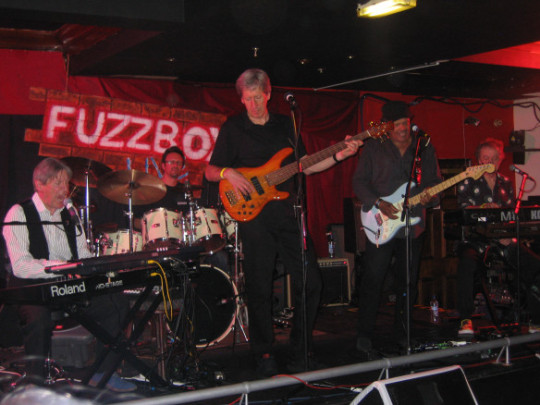
Bobby Tench
My point is, Alan gets around.
#I couldn't find anything for Alan Price and the Electric Blues Company#Or Alan Price and Friends#or Zoot Money#Alan Price#The Alan Price Rhythm and Blues Combo#The Alan Price Combo#The Alan Price Set#Price and Fame#Georgie Fame#The Animals#Bobby Tench
3 notes
·
View notes
Note
I'm curious, what actors would you see in absolutely anything, even bad movies?
Oh! I def have some actors that I watch everything they do. In fact, If I got paid for every bad movie I've seen by an actor I like, I'd be a millionaire by now. Especially with Ciarán Hinds lol
The worst thing is that 80% of my favorite actors usually have supporting or really secondary roles so it almost always happens the combo of shitty movie + 3 seconds of screentime :)
Sooo, in no particular order
Ciarán Hinds
Kenneth Branagh
Alan Rickman
Dirk Bogarde
John Turturro
Stephen Rea
Colin Firth
Gabriel Byrne
Richard Burton
Alfred Molina
Timothy Hutton
Marcello Mastroianni
Vincent Price
Cary Grant
15 notes
·
View notes
Text
433. Just some Windows 95 things (August 24-25, 1995)

I was reminded of this because as we all know by now, Bill & Melinda Gates have broken up.
I immediately thought of the Douglas Coupland’s classic Microserfs when the characters (who previously worked at Microsoft) found out that Bill & Melinda got married in early 1994:

Then, I remembered Start Me Up.

Which I always associate with the launch of Windows 95 in the late Summer of 1995, because it was used big time in the commercials for the operating system.
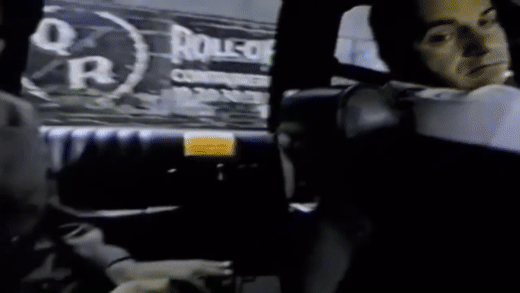
[The lady in commercial using laptop in a taxi cab -- who was doing that in 1995 -- who is doing that today?]

(source)
I also associate Windows 95 with my mom and I going to WalMart on a regular basis that Summer. WalMart was a ~new thing~ for us after we avoided it for the first few years of it being open in our town due to store being ~too crowded~. On the outside of our WalMart, there was this huge banner advertising Windows 95 arriving on August 24th. It looked just like this photo I had to mock up in Pixlr because I surprisingly couldn’t find one online.
From my local newspaper, Daily Press:

Cold Pizza Hut < Windows 95 at the CompUSA in Norfolk. 2,000 customers at the midnight launch!

"I know i'll want this, it will be perfect for me.” - Sal


OS/2 was IBM’s operating system. It’s last version came out in 1996.

Here’s the Coke commercial. I’ve noticed in nearly all the photos I’ve found of guys in stores buying Windows 95, they’re all dressed like Bill. That polo shirt/baggy khaki combo.
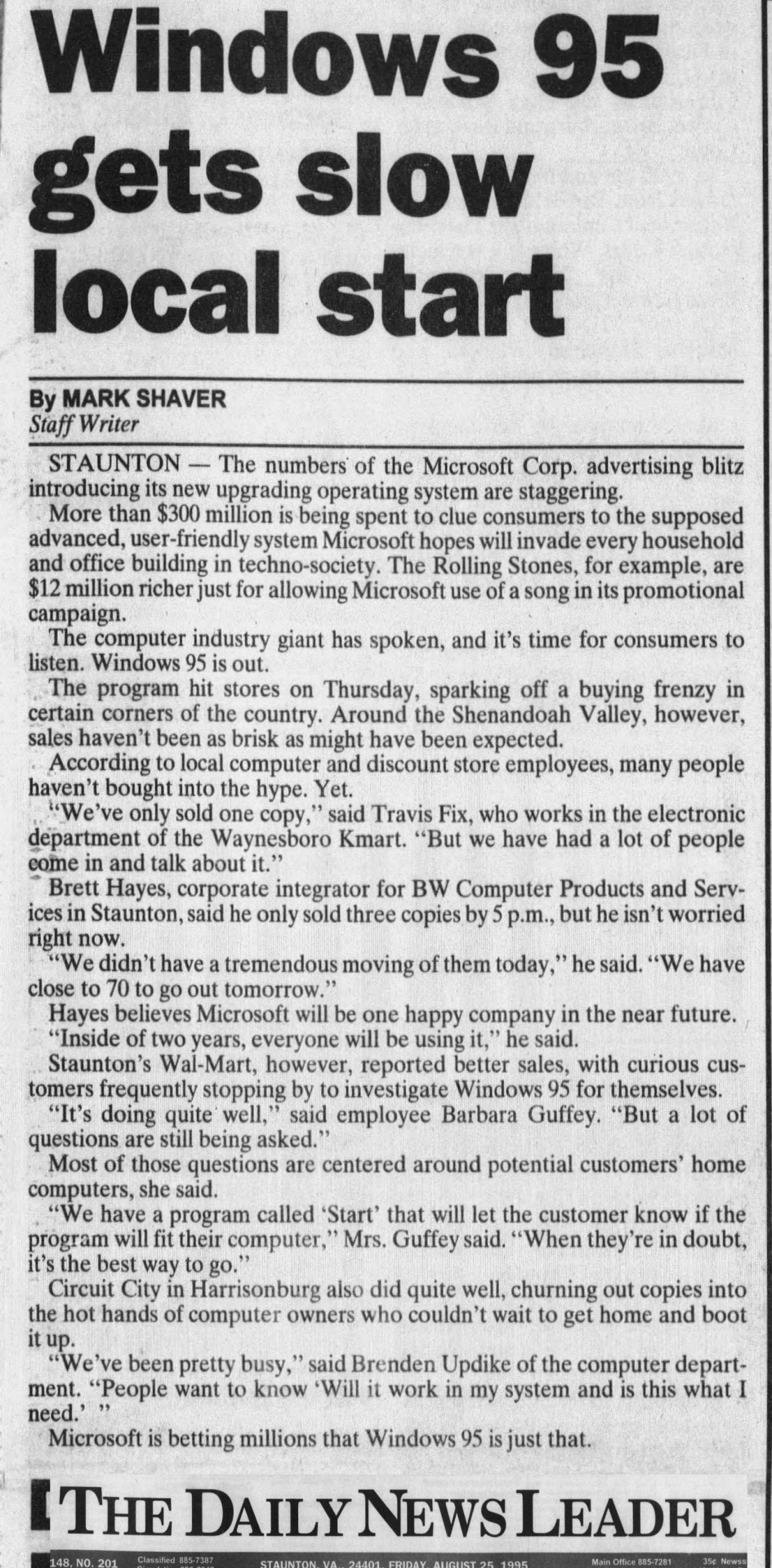
I got excited to see that I could find archives of the newspaper from Staunton, VA, where I lived for 2 years while I finished college. Only one person bought it at the KMart in Waynesboro!

While tropical storm-like weather plagued Central Florida, Alan Blalock still went out in the elements to get a copy.


The price signs at Sam’s Club still look like that in 2021.



Wait, so Allen in the photo bought it on launch day, but wasn’t installing it until the end of the year?
Jay Leno helped Bill Gates introduce Windows 95 in a show shown at computer stores. Of course he had to tell a lame O.J. trial joke:
Windows 95 can do so many things, it can keep track of all of O.J.’s alibi at once.

I still haven’t found any news coverage of these “computer geek costume balls”.



At CompUSA you could take a 3 hour $79 class on Windows 95.

Even Rachel and Chandler got into the Windows 95 hype. They were the stars of an infomercial video for the software. Rachel thought that cutting and pasting files was “trippy”. Check out that ergonomic keyboard! Love those.
Facebook | Etsy | Retail History Blog | Twitter | YouTube Playlist | Random Post | Ko-fi donation | instagram @thelastvcr
#windows 95#bill gates#1995#windows 95 launch#jennifer aniston#matt leblanc#compusa#walmart#computers#1990s culture#1990s#doulgas coupland#microserfs
21 notes
·
View notes
Photo

Eric Victor Burdon (born 11 May 1941) is an English singer-songwriter and actor. He was previously the vocalist of rock band the Animals and funk band War. He is regarded as one of the British Invasion's most distinctive singers with his deep, powerful blues-rock voice. He is also known for his aggressive stage performances.
Burdon was lead singer of the Animals, formed during 1962 in Newcastle upon Tyne. The original band was the Alan Price Rhythm and Blues Combo, which formed in 1958; they became the Animals shortly after Burdon joined the band. The Animals combined electric blues with rock; in the US they were considered one of the leading bands of the British Invasion. Along with the Beatles, the Rolling Stones, the Who, the Hollies, the Dave Clark Five, and the Kinks, the group introduced contemporary British music and fashion to American audiences. Burdon's powerful voice can be heard on the Animals' singles "The House of the Rising Sun", "Baby Let Me Take You Home", "I'm Crying", "Boom Boom", "Don't Let Me Be Misunderstood", "Bring It On Home to Me", "We Gotta Get out of This Place", "It's My Life", "Don't Bring Me Down", "See See Rider", "Monterey", and "Sky Pilot".
In 2008, he was ranked 57th in Rolling Stone's list The 100 Greatest Singers of All Time.
Daily inspiration. Discover more photos at http://justforbooks.tumblr.com
27 notes
·
View notes
Text
John Steel icons 🧡
The first is from my friend and The original photo is John with Chas @the-alan-price-combo


#The Animals#The Animals icons#john steel#John Steel icons#english musicians#british invasion#1960 music
2 notes
·
View notes
Text
In The Beginning (1959-63) -
All Sections | Next Section
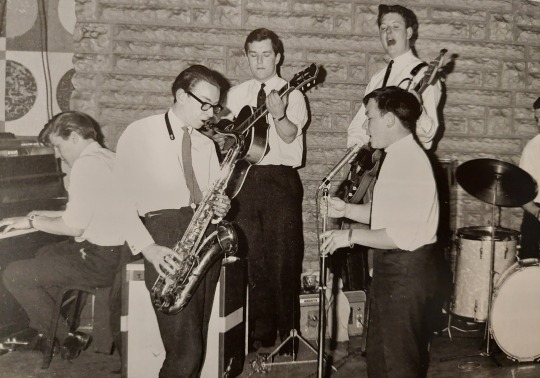
[Interviewer: “But then, of course you came together as the Animals. Now, tell us about the Animals, because that was the first time you really made it, wasn’t it? Was the Animals?”]
“I don’t know whether you can say there’s a first time. I think, really, when I met Eric for the first time was when I ‘made it’, because I found somebody with a common soul, you know?” - Alan Price, Northerners, 1975.
Alan… Alan, I swear!! What a way to describe your connection with someone…
Anyway, this section is going to be dedicated to miscellaneous things from ‘59 to early ‘63, most of these events not having exact dates tied to them, but still documented and decidedly pre-Animals.
Friendly Competition -
An interesting group of shared events Alan and Eric talk about involve talent competitions they would compete in; not with bands, but by themselves. The date of Eric’s particular recounting is unknown, but it appears to be sometime in ‘58 or ‘59, during a talent competition at the Majestic Ballroom:
“...I saw a list of the other competitors. One name stood out, and I caught a glimpse of him at the bar. His name was Alan Price. I’d seen him before at the Methodist Church Hall, doing Larry Williams’ ‘She Said Yeah!’ with a group fronted by Thomas Hedley. He was fucking good. And on this night, he was planning to do his rendition of Jerry Lee Lewis’ ‘Whole Lotta Shakin’’. I kind of knew then that I was sunk. This guy sang and played piano. I figured I didn’t stand a chance just singing with a big band, especially with such a straight crowd…
“…I knew before either of us went on who was going to take the show.
“At the side of the stage, Alan came up and said hello. He told me that he’d been playing with Hedley’s group, but that he was playing guitar, not piano, which he would have preferred.
“‘Well,’ I told him. ‘We’re thinking about putting a real R&B band together. You can play piano with us anytime.’
“When the band leader announced Alan’s name he climbed onstage, headed right for the big black Steinway, and the 88s began to roll. Microphone stand between his legs, hair flopped over his forehead, Alan got into it, speeding up at the end and throwing off the big-band drummer, just like Jerry Lee.
“When he walked off, Alan seemed surprised at the enthusiasm of the applause, but this was basically a straight crowd seeing and hearing live rock and roll for the first time!
“At least he warmed them up, I thought as I was called on next.” - Eric Burdon, Don’t Let Me Be Misunderstood, 2001 (p. 11).
Eric ended up winning this particular competition, however, Alan has a little more to say about these talent shows…
“Eric is an old, old friend and figures a lot in the formative days of Alan’s musical career. Alan recalls a holiday with him at Butlins.
“‘We paid for it by winning talent competitions,’ he says ‘Eric did a wonderful Presley act and I won the musical section with my Jerry Lee Lewis impression.’” - Beat Instrumental, November, 1966 (p. 6).
…So you went on a private vacation, just the two of you, that you paid for with the money you pooled together from talent shows? …hmm… Said holiday doesn’t seem to be elaborated on further by either of them, besides by Alan in this one article… but to be fair, it doesn’t need to be.
Anyway, this is a perfect representation of the immense amount of respect they had for one another’s talents. A common, misguided observation of most interpretations of their relationship is the idea that neither of them seem to want to “back down” in relation to one another, per-say (which is somewhat true, they are both quite stubborn). However, if there’s one undeniable consistency within their dynamic, it’s that they never lose respect for one another and will always acknowledge when the other is performing well. Enjoying the other’s talents, unabashedly.
Emergence of a Combo -
Amongst all of this, the fundamental elements of what we now know as the Animals were beginning to take shape. Once Alan had joined the Pagans, they had changed their name to the Kansas City Five (KC5); however, he didn’t stick together for too long. After performing with the KC5 for a few months, Alan ended up being a no-show at a particular gig, having been snatched by another band known as the Kontours. It was within this group that Chas Chandler entered the picture, supplying bass guitar within the Kontours. Around this time, the Pagans/KC5 were beginning to disband, with Eric making a trip down to London to explore the scene there and John taking on a real job while playing music on the side. The Kontours had their own fluctuation in members, with Chas and Alan seeking out musicians and the Alan Price Combo emerging from this unit (John was in and out of the band for a time). Like the others, working slightly more stable jobs alongside their musical hobbies, Alan was employed at an income tax office during this time.
Meanwhile, for Eric, London was an unforgiving place; musically and as a general environment, and he was intrigued, especially by the blues music he was hearing. While Alan describes Eric coming back from London as “with his tail between his legs” (Alan Price tour program, 1975), Eric seemed to have a much more excitable, hopeful outlook on things.
“I returned to Newcastle full of enthusiasm, going from one friend’s house to another, telling them they must see what was cooking in London. I made a special trip to Alan’s place of employment, a tax office in the city centre. I told him he must go to London. But Alan was very serious about finishing his time at the tax office and making sure he was secure for life. One day, when the time was right, he too would feel the pull of the smoke.” - Eric Burdon, I Used to Be an Animal, but I’m All Right Now, 1986 (p. 35).
Such a great description of Alan’s outlook on things, courtesy of Eric… I love the phrase, “feel the pull of the smoke”, which can mean just as much or as little as you want it to. Eric knew Alan had reservations, and even once he was physically in the city, he still wouldn’t entirely be there and Eric didn’t pressure him; not too much, at least. Instead, he provided excitable suggestions, wanting their band to flourish. Wanting to work together again.

The Alan Price Combo, circa 1962. Note Chas on the bass!
Giving Up the Reigns -
However, Alan’s hesitation didn’t just surround “moving to the big city”. No… he had further reservations… mostly revolving around Eric himself. This is where things get just as speculatory and muddled as they are clear-cut. Alan definitely harbored a bit of jealousy towards Eric, which became obvious when Eric held the ‘lead singer’ role in their groups. Just by the nature of this musical position, Eric is the focal point of the band; the focal sound of the band. This was true in the Pagans and KC5, and would be true in the Animals… and if Eric was to join the Alan Price Combo, it would happen there. Eric’s voice would dominate the others, dominate Alan’s piano, dominate Alan’s own voice, and this was something the prickly and stubborn Alan Price didn’t like very much at the time. Sure, Chas and John didn’t take any shit, but their particular instrumentation meant they were never a “threat”. Eric was a “threat” to his image and his sound…
“I don’t think AP could deal with me as the front guy. His attitude is, ‘Here I am, I’ve studied piano all my life, I’m the musician in the band, and this fucker’s out front getting all the adulation.’ The guy’s got problems. Always had problems. Great player, no doubt about it. He was the Animals to a certain degree.” - Eric Burdon, Animal Tracks: The Story of the Animals, 2012 (p. 82).
Now, this sounds mighty antagonistic, doesn’t it? …Yeah, it does. However, this behavior in Alan doesn’t last too long. And the fact that he did harbor these feelings at this time makes many of the things he does a few years from now hold a lot more meaning, indicative of how much he will embrace Eric’s presence in his life… but, we’ll get to that later.
Though, as a small aside - and I might just be reading too much into this - but Alan’s behavior in trying to avoid the inevitable (Eric eventually joining their group) gives me “furiously avoiding his crush” vibes…
Here’s some of the Animals’ takes on the early Burdon-Price dynamic:
“It was Alan who had organized the band from the start. But he realized that he didn’t have the voice for that kind of material. He had to get Eric in. From then on, it was Eric who had the ideas, even though Alan was the leader of the band.” - John Steel, Wild Animals, 1986 (p. 21).
“[Price] did the administration, he was the one that got the money and divided it out, but Eric seemed to be the dominant one.” - Hilton Valentine, Animal Tracks: The Story of the Animals, 2012 (p. 30). (lol thanks Hilton, I kind of figured)
[Interviewer: “Was there an element of frustration with Alan Price wanting to be lead vocalist when he knew damn well that you were doing a fine job, and he really didn’t have much of a chance?”]
“To the outside world, it would appear to be that it was a problem of Alan and his need to be heard, vocally. Maybe it was. I didn’t see it that way because my relationship with Alan was always a love-hate, delicate relationship from the very beginning.” - Eric Burdon, BBC Interview (https://www.youtube.com/watch?v=SFTtReqO9bs&t=0s)
“Love-hate, delicate relationship”... believe me, the first time I heard this, I just about fell apart at the seams. Because, yeah, despite the tension, there was something very delicate there…
Anyway, hello, Hilton Valentine! Of course, he was the last piece of the Animal-puzzle, joining in mid-’63, after Chas had seen him performing around clubs with a skiffle group known as the Wild Cats. He was honestly the perfect final addition, not only providing the lead guitar the group desperately needed, but also more of that rock-image, which Hilton was practically schooled in. John also permanently joined around this time, truly rounding the group off. At this point, the band was still referred to as the Alan Price Rhythm and Blues Combo, however, this wouldn’t last for too much longer…
Music to His Ears -
I talked enough about Alan being a bit prickly and restating what dozens of online articles who don’t read obscure Beat Instrumental articles daily have said already, so let's get to the beginning of the absolutely soft content. Again, this is something they were basically doing since ‘59, and probably later on throughout the decade, but it’s most documented and palpable here.
Eric had a huge impact on Alan musically, because one of the things Eric would do was sit him down and play Alan records that he hadn’t heard much before; of pianists he hadn’t heard much before. Pete Johnson, Memphis Slim, accompanying pianists on Gene Vincent and Elvis records… and, of course, Ray Charles. This was a world of wonder Alan had never had the chance to fully be exposed to before, and after hearing this music for the first time, he would try and emulate it on a piano as soon as he possibly could. Eric knew how good Alan was with his jazzy, more lounge-ish style, as well as church-esque music… but he also knew he could foster a more bluesy, more rock-based sound within him as well. And Alan not only let him… but considers these moments they shared to be some of the most formative in his entire career.
“Eric was always introducing me to new artists which I hadn’t come across before.” - Alan Price, Beat Instrumental, November, 1966 (p. 6).
“Eric is an old, old friend and figures a lot in the formative days of Alan’s musical career. …It was the music he heard through Eric that made him a follower of quality, a seeker after big sounds, as near perfect as perfection itself.” - Beat Instrumental, November, 1966 (p. 6).
“I think, perhaps, if there were any big influences, musically there was Ray Charles, in the beginning, and all of rock and roll, but Ray Charles, because he sang like I felt. I didn't want to imitate him, I didn't want to do a Joe Cocker.
“The next one was Eric Burdon, who educated me to blues music in the real sense of the word, Joe Turner, Pete Johnson, and I found I could play like these people. It's funny to find out you can actually play. I mean, when you're self-taught and you can't read, and you suddenly play and you find that you are playing what these people are playing, as well as getting the same thrill, that's a nice sense of identification…
“…I'd say I owe most to those two, Eric and Lindsay [Anderson].” - Alan Price, interview from October, 1975 (http://www.muzines.co.uk/articles/alan-price/6673)
“Alan didn’t know much about blues until Eric started ramming Ray Charles at him. He was more into Jerry Lee Lewis. But it was always Eric who had dug out some good, unheard-of blues thing or other. …It was Eric who was always looking for that kind of stuff, and Eric who was always wanting to play it.
“If it hadn’t been for Eric, I expect Alan Price would still be a tax inspector, playing Jerry Lee Lewis on the side.” - John Steel, Wild Animals, 1986 (p. 17).
Shout-out to John Steel for saying one of the absolute most telling statements up to this point. Because… yeah, he’s completely right: Eric changed Alan’s life for the better… and Alan seems to agree. Eric completely shifted his outlook on music and the way he would approach his own style… and this would have a profound impact on the sound they created together.
Also, the image of an excitable Eric and a curious Alan huddled around a record player, just the two of them, is adorable. Wonder if they did a lot of “listening” on that holiday they went on together…
All Sections | Next Section
3 notes
·
View notes
Text
This is the new appearance of The Animals in Season three (this outfit appears for first time of end of season two) of The Animals Series.
This outfit are inspired a draw by @the-alan-price-combo


#gacha club#The Animals#The Animals Series#hilton valentine#chas chandler#john steel#alan price#eric burdon
0 notes
Text
The Dark Animals Collage with their fanart version by @the-alan-price-combo





#gachaclub#villain fanart#The Dark Animals#The Animals Series villains#The Animals Series#The Dark Animals Collages#The New Adventures of The Animals Series#The New Adventures of The Animals Series villains#dark alan price#dark hilton valentine#dark eric burdon#dark john steel#dark chas chandler#The Animals villains
1 note
·
View note
Text
Review: Silverline SR17 Supreme loudspeaker

Silverline SR17 Supreme loudspeaker
The Audiophile Weekend Warrior (TAWW)
TAWW Rating: 5 / 5
Combining the body and scale of a larger speaker with traditional mini-monitor virtues, the SR17 Supreme is an exceptional conveyor of musical color and expression.
PROS: Organic midrange tone; top-to-bottom coherence; ample scale and dynamics; superb imaging; unfussy setup.
CONS: Smidge of lower midrange coloration; favors acoustic over electronic music; awkward recessed terminals.
This review has been a long time coming. Back in 2010, @mgd-taww gave the Silverline SR17 Supreme (USD $7,500) a rave review in Bound for Sound magazine, and heartily recommended them to me as an upgrade to my Merlin TSM speakers. It took me 8 years and a move to the West Coast to finally reach out to Silverline for a review pair; then another 15 months of listening to get around to this review. In the meantime, lots of speakers have come and gone in the market, particularly in the 2-way monitor category saturated with offerings at every conceivable price point. And yet, to my ears, the SR17 Supreme endures as one of the most satisfying speakers of its kind. Read on for my take on how it’s withstood the test of time.
History & Design
Silverline is a small speaker manufacturer based out of Walnut Creek, California, a short drive northeast of San Francisco. The SR17 is one of their first models dating back to a couple years after their incorporation in 1996:
1998: The SR17 debuted at the 1998 Stereophile Show in LA, sporting a Dynaudio D28/2 tweeter and Esotec 17WLQ midwoofer.
1999: Updated with an Esotec D260 tweeter and revised crossover.
2004: The SR17.5 was introduced, with increased internal volume via a deeper cabinet for better bass response.
2009: The SR17 Supreme is introduced with an Esotar T330D tweeter and further refinements.
Proprietor/designer/craftsman Alan Yun has continued tweaking the Supreme over the last decade, and though the Dynaudio drivers he prefers are out of production he’s stockpiled enough units for years of production and repairs. The enclosure, recognizable by its trapezoidal shape and depth, is manufactured in China by a shop that does cabinet work for a number of high-end marques, with final assembly performed by Alan’s own hand. He shared a bit more about their production:
California has strict environmental regulations. The paints on cabinets are governed by strict rules, and is why there are fewer and fewer cabinet makers in California. Many manufacturers now find their production overseas.
Actually our cabinets were rawly made in China, painted, and the final detailing is done by me, also putting sonic materials inside the cabinets. This job is pretty tricky for tweaking the sound. The crossovers were handmade by me, matching components, soldering, etc. The drivers were fitted carefully and precisely by my hands with European-made T-15A screws. Final testing and listening are all done by me in my workshop. 😅 Therefore, the SR 17 is rather unique. I am also the original designer of this shape/type of speaker cabinet since 1996. I did research and to the best of my knowledge there were no similar designs then.

Large, but not ungainly, atop Dynaudio Stand 6′s
The depth of the cabinet - 15 inches, to be exact - gives it a rather top-heavy look on a typical stand, but it’s mitigated by the elegant tapered profile. My pair was impeccably finished on all sides in rosewood veneer. Rapping down the sides revealed it to be very solid, but not as fanatically braced and damped as my old Merlin TSM monitors or the Audiovector SR 1. Each speaker weighs around 26 lbs. The bi-wire terminals are recessed, which made them a bit of a pain, particularly as they have larger rectangular posts that will take 1/4" spades only in certain directions - I recommend banana terminations.
The crossover sports just 4 components, with 1st order high-pass (tweeter) and 2nd order low-pass (woofer) filters. Parts quality - Solen metallized polypropylene capacitors, a generic-looking wirewound resistor and an air-core inductor - is solid but hardly fancy, a deliberate decision by Alan who isn’t much of a believer in expensive boutique parts. Based on the results he’s achieved here, it’s hard to argue.
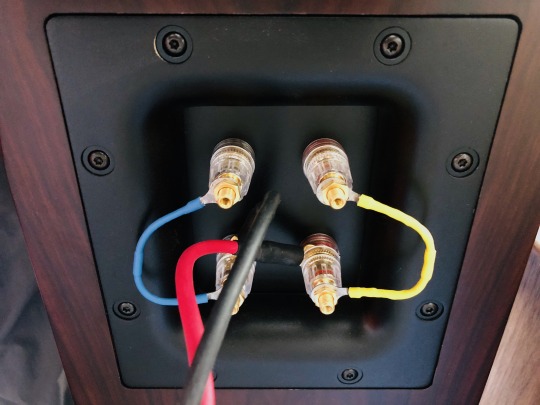
Cardas jumpers sounded better than the stock bridges to my ears. Stick with bananas for the cable termination - spades are awkward.
Setup
The SR17 is fairly efficient (nominally 90.5 dB/watt @ 8 ohms), but more importantly it's easy to drive - my Ayre AX7e, known for being rather limited in the power delivery department, sounded open and effortless. Alan Yun said the Dynaudio drivers love current and will benefit from powerful amplifiers, yet will sing with low-powered tube amps. I can confirm it loved the grunt of the 300wpc Bryston 4B Cubed, yet I never felt lower-power amps like the Ayre or Bryston B60 integrateds were lacking for dynamics. And my favorite pairing by far was with the 55-watt Valvet A4 Mk.II class A monoblocks sporting a single pair of bipolar output devices. (Incidentally, Alan’s favorite amp paring with the SR17 is the 30-watt Pass Labs XA30.5, which @mgd-taww can attest to being a magical combo.)
Similarly, I found the SR17 easy-going when it came to cables. My preferred cable had more to do with the amp used, but I got good results from a single run of Audience Au24 SX [review], Cardas Clear Light and DH Labs Q10 Signature cables. With the Audience, I felt the speaker was the sweetest and most dimensional; the DH Labs brought out more bass power and treble brilliance; while the Cardas brought out more upper midrange presence. With the Bryston 4B3 amp, I settled on the Cardas; with the Ayre and Valvet, the Audience was the clear winner. Unlike with the Audiovector SR 1 Avantgarde Arreté (review forthcoming), I didn't find bi-wiring to lend a noticeable improvement, but I did prefer replacing the stock metal jumpers with nicer Cardas ones from my Merlin TSM's for a little more refinement.
As with any high-quality monitor, stands are important. Something around 24-25” height seems right, though I wouldn’t be afraid to sit them an inch or two lower as the speakers are capable of projecting good image height. A trend these days is to decouple speakers from the stands/floor, but the SR17’s are “old school” in that they prefer tight coupling, meaning heavy suckers with spikes and a judicious amount of BluTack on the top plate. My old Osiris stands, heavy dual-column steel beauties loaded with sand, were a perfect match, but sadly I sold them with my Merlin TSM’s; they were replaced by higher-WAF but inferior-sounding Dynaudio Stand 6’s, which in stock form are quite light and choked the sound of the Silverlines. Fortunately I was able to get them to a better place with some tweaks; not as good as the Osiris, but close. A better choice sonically might be something like the Target Audio MR stand with the four pillars mass-loaded.

Pulling them out further improves imaging, but they still work well relatively close to the back wall.
Placement was pretty standard for a monitor speaker - keep it at least a couple feet from the back wall, with a 2:3 width-to-listener distance ratio and toed in about halfway. In my room, which has a number of living constraints, I had the back of the speaker about 21” from the wall, tweeters 76” apart and the plane of the speaker 8 ft. from my ears. While many small-box monitors rely (often excessively) on rear ports for low-end boost, the bass tuning on the SR17 is far more subtle and sophisticated - putting my ear to the port, I heard a fairly modest amount of output. I remarked this to Alan, and he described the port as more a method of pressure equalization than bass volume. This means in a pinch I could push the speakers as close as 12" from the wall without fear of low notes booming out of control. All in all, for being such a high-performing design, the SR17 is remarkably easy to live with.
The Sound
The first thing my wife, a professional oboist, noticed about music through the SR17 is how dynamically alive it was. I had just wrapped up my review of the Silverline Minuet Grand, a superb $2k speaker that is no dynamic slouch itself. And even though the SR17 was fresh out of the box and Alan warned me it would take some time to run in, the very first notes from the SR17 sung with expressiveness and vibrance. I think it took all of 15 minutes of listening to Royal Concertgebouw Orchestra streaming radio for her to remark, “I like this speaker.” She’s normally nonchalant about hi-fi, and yet has ears that can pick apart sonic deficiencies in about 90 seconds, so that amounts to a rave! And what made it so immediately engaging wasn't some artificial emphasis or hype; it was a feeling of unimpeded dynamic flow that makes most other speakers sound a bit drab. The SR17 lets music breath freely, carrying you with the ebb and flow of a tune and conveying every turn of a phrase with a sense of ease and conviction.
The next thing we noticed is how natural and palpable everything sounds through the SR17. Tonally, the SR17 is on the very slightly warm side of neutral; it combines reassuring solidity and density from the mid-bass through the midrange with an open, extended top end and fine harmonic resolution. Its ability to paint with a wide palette of tonal colors brings out the distinctive character of instruments and voices, making orchestral music a delight - just put on a Living Stereo recording such as Debussy’s Iberia [Tidal, Qobuz, Spotify] and the front of your room will explode with the virtuosity of the Chicago Symphony Orchestra’s playing. Scale it down to smaller stuff like a Beethoven string quartet, and you’ll savor the finer gradations of timbre between the cello, viola and violin.
What you won’t notice is any discontinuity between the woofer and tweeter. These Dynaudio drivers were made to work together, and the minimal crossover mating them is superbly executed. The upper midrange around the crossover point is seamless, and I can’t remember a single moment over the course of hundreds of hours of listening when I noticed the tweeter sticking out on the face of the speaker, something that ails even the finest, most expensive dynamic speakers from time to time. In this respect the SR17 is up there with the very best and is utterly free of listening fatiguing.
As a violinist, I feel obliged to point out the Silverline’s superb reproduction of the violin G string. If you ever want to test out a speaker’s tonal truthfulness in the lower midrange (right around middle C, 262Hz), put on the 2nd movement of the Glazunov violin concerto performed by Jascha Heifetz [Tidal, Qobuz, Spotify], or the 2nd movement of the Sibelius concerto performed by Lisa Batiashvili [Tidal, Spotify]. This is oh-so-tricky to get right; as the lowest string on the instrument, it’s the richest and deepest; and yet the violin is not a viola or cello - it’s a more subtle and delicate richness. Speakers that lack body will sound thin and washed out and minimize the difference in timbre vs. the D string above; woolly or bloated speakers will thicken it or blow the instrument out of proportion. The SR17 performs this balancing act better than anything I’ve heard in my living room, or in most any system for that matter. It rides the line between warmth and clarity in that register, lending tangible realism to piano, male vocals and low brass instruments as well.
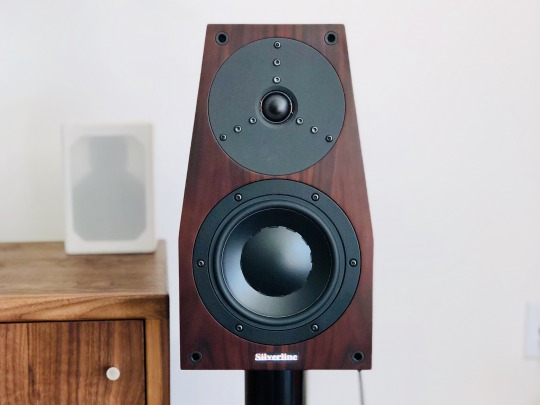
Going down the frequency range, the SR17’s extra cabinet volume vs. a typical mini monitor gives it power and scale more akin to a floorstander. My room is a 17 x 19 x 8.5 ft. open layout living/kitchen area with floor-to-ceiling windows and an offset listening point along the long wall, so while not huge, it presents a bit of an acoustic challenge that smaller speakers have struggled to fill. The SR17 had no trouble projecting a big, bold sonic image, and can cleanly play as loud as you’d reasonably want in such a space. It has sufficient body and power down to 60Hz or so to give music real foundation, with meaningful output down to 40Hz. I think Silverline’s quoted 32Hz bottom limit is a bit optimistic (or perhaps you just need the right room), and I preferred the speaker with my REL T-9 subwoofer providing a little extra oomph. But for a great many listeners in moderately-sized spaces, this will be all the speaker you ever need. Listening to “The Elephant” from Saint-Saëns Carnival of the Animals [Tidal, Qobuz, Spotify], a track I’ve heard on some very full-range speakers (e.g. Focal Grande Utopia EM Evo), the double bass is big and present, lacking a bit of rumble that was easily provided by flipping on the REL sub. Piano left hand similarly has nice weight, never sounding diminished in scale as typically happens on small monitors. Debussy’s Ariettes oubliées song cycle from the album Paysages by soprano Susanna Phillips and pianist Myra Huang [Tidal, Spotify] is a lovely test of colors, with ethereal vocals floating above dark undertones from the piano’s lower register. The Silverline possesses suficient extension and body to bring out these contrasts with depth and balance.
At the opposite end, the old-school Esotar tweeter is still one of the most musical high frequency transducers around. It balances detail with smoothness, extends low enough to mate perfectly with the woofer, and never sounds strained - a substantial upgrade in resolution and realism over the typical metal or silk domes in lesser speakers. In top-end extension and speed it might be bettered by some of the newfangled devices like Focal’s beryllium or B&W’s diamond domes, Scanspeak’s latest Revelator or the fantastic AMT in the Audiovector SR 1, but it’s a relatively small sin of omission and a worthwhile trade off to avoid any hint of unnatural edge or ringing. And it still has plenty of sharpness and sparkle, lending nice bite to trumpets and sheen to triangles and cymbals.
Last but not least, there’s that soundstage - present and tactile, but never in-your-face. Particularly when coupled with gear with sufficient resolution to relay subtle ambient information, e.g. the Pass XP10 preamp, there’s a real sense of the layout and layers of a symphony orchestra. The hi-res LSO Live recording of Mendelssohn’s "Reformation" Symphony with the London Symphony/Gardiner [Tidal, Qobuz, Spotify] paints a vivid picture of the stage of the Barbican, with brass fanfares anchored closer to the back wall of the fan-shaped stage, and the smaller string section sounding up front and intimate. An interesting twist in this performance is Sir Gardiner had the violinists standing to emphasize the virtuosity of Mendelssohn’s writing, and while I can’t say I would have been able to tell this from listening alone, the Silverline does convey a subtle sense of freedom and space to the violin section that I’ve missed when listening to the recording on other systems. And it has no trouble imaging well outside the bounds of the speaker, with percussion and harp on the extreme left of the stage floating eerily behind and beyond the left speaker.
I think my wife put it best when I asked her one day how the system sounded with the Silverlines: “this is what I imagine it sounded like in the concert hall.” While I’ve broken down a bunch of its strengths in audiophile terms above, it’s the way it puts everything together into a musically vivid whole that makes it special. There’s an evenness of tone, a naturalness of perspective, an ease of dynamic expression, a consistency of refinement from top to bottom that gives music a sense of rightness that allows one to forget the hi-fi aspects and focus on the musical performance. In this respect, Alan Yun has crafted something truly masterful in the SR17 Supreme.
Caveats & Comparisons
I’ll nitpick a few things that were relatively minor deficiencies to my ears, but may weigh more heavily for people with different tastes. These were highlighted in my own home by direct comparison with another very fine monitor speaker, the Audiovector SR 1 Avantgarde Arreté ($6,200 in premium finish). I also have my long-term reference, the Merlin TSM-MXe (around $6k several years ago) as a baseline.
First off, I suspect the Silverline’s hint of lower midrange warmth, while sounding natural and consonant with much of my favored acoustic music, may come from a bit of otherwise well-controlled cabinet resonance. It gently highlights the woody quality of acoustic instruments, but with electronic music it comes across as a slight coloration - a bit like wearing orange-tinted sunglasses that make everything look a little less cool. It’s very subtle, and not enough to sound overtly “boxy” or throw voices off, but it’s not transcendentally-clean like the Audiovector or, say, a Magico. My sense is Alan wisely tuned the SR17 cabinet for this response, as additional bracing would just make the resonance peakier and higher in frequency where the ear is more sensitive; as it is, it’s a gentle and diffuse coloration. Part of this may also be the sonic signature of the Esotec woofer’s magnesium silicate polymer cone, which I’ve heard in a number of speakers and to my ears trades better damping for a hair less crispness vs. some of the fancier treated paper or composite cones out there. On the plus side, it never sounds dry as some of those drivers can, but with Erlend Øye’s Unrest [Tidal, Qobuz, Spotify] or Carley Rae Jepsen’s Emotion [Tidal, Qobuz, Spotify] I found the Audiovector conveyed more of hard-wired immediacy and edge suitable for those albums.
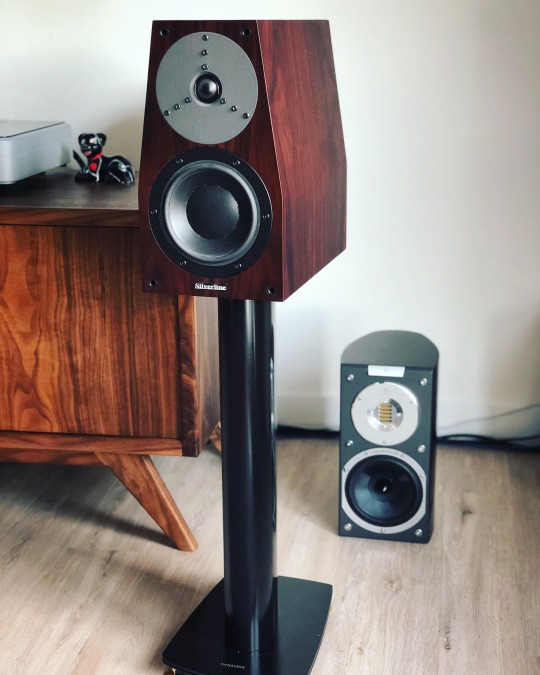
Taking turns with the Audiovector SR 1 Avantgarde Arreté
Another area where the Audiovector came out slightly ahead of the Silverlines was in resolution during loud dynamic peaks. The Audiovector is truly special in this regard, being designed for minimal signal compression and sounding incredibly collected the louder you play them. The Silverline also plays loudly with ease, but vs. the über-clean Audiovector it’s very slightly thicker and more congested. Case in point are the fortissimo climaxes and interruptions in Rossini’s L’italiana in Algeri overture [Tidal, Spotify] - when the orchestra comes crashing in after the pianissimo pizzicato opening, both speakers are clean and explosive, but the Audiovector sorts out the different instruments playing in unison for that brief moment a hair better, while the Silverline has more low-end oomph.
As mentioned prior, the Silverline’s superb Esotar tweeter isn’t the state-of-the-art in extension. It has plenty of resolution, but if you favor extremely extended and airy highs, e.g. the 52kHz-rated AMT tweeter in the Audiovector will give you more of that. I don’t think that ultimately matters so much for musical enjoyment (and many people can’t hear very well above 10kHz anyway), but it does make a subtle difference in realism. It also makes the Silverline’s treble a bit more forgiving of poor recordings and upstream components (silver cables could work) - it’ll never, ever burn your ears off.
The $7,500 price tag of the Silverline puts it squarely above the very crowded $5k-and-under monitor crowd, but short of the $10k+ “super monitor” category. Comparisons with other speakers are more conjecture on my part as I haven’t heard them in my own room... but I’ll mention a few things I’ve gotten a good listen to at shows, dealers, and other people’s systems.
Paradigm’s Persona series seems to be mentioned quite frequently in audio forums these days, and I heard the Persona B monitor ($7,000) briefly at RMAF. I’ve also listened to the floorstanding Persona 3F a bit, and there’s definitely a common house sound - fast, crisp, detailed and dynamic. I’ve never warmed up to either of them - they’ve struck me as rather strident, with instrumental interplays like oboes and clarinets playing in harmony tending to sound compressed. The Silverline by comparison may sound a bit thicker, but it has far more natural instrumental timbre to my ears, is less bright and thus easier to match to more systems, throws a more dimensional and properly-placed soundstage, and is very nearly as “fast” without sounding edgy. I’m honestly at a loss as to why the Personas are garnering so much praise, so maybe it’s just me? A similar argument could be made for the B&W 805 S3 ($6,000) - while I haven’t auditioned them specifically, I’m pretty familiar with the 800-series sound and again, it’s not my cup of tea. The Silverline’s balance and openness just strike me as much more natural than anything I’ve heard from B&W. So if the likes of B&W and Paradigm leave you a bit cold, the SR17 Supreme might be a step in the right direction.
An obvious comparison is to Dynaudio’s own bookshelves, specifically the Contour 20 ($5,000) and Special Forty ($2,995). You can read about them in my quick review from a dealer audition, and while I haven’t heard them head-to-head, I posit that the Silverline a worthwhile step up in coherence and musicality. If you can’t stretch the budget for the Silverline I think the Special Forty would be a good alternative, but it does not have the near-reference level neutrality of the Silverline. In the past Dynaudio had a bit of a reputation for not being as good at implementing their own drivers in complete loudspeakers as other companies were, and while I think their latest efforts are much improved, Alan Yun still seems to be squeezing more out of the old Esotar/Esotec drivers in the SR17... methinks this is a reflection of Alan’s sharp ear and painstaking hand-tuning.
A few more offhandish observations based on extremely limited auditions, so take with a block of salt: I heard the Wilson Audio TuneTot ($9,800) at a dealer shortly after its release. With the caveats that it’s designed for a totally different use case, it was in an unfamiliar setup and this pair wasn’t fully run in, I didn’t find it nearly as compelling or expressive. I got a good listen to the TAD Micro Evolution One ($12,495) with a couple different amps and found its midrange rather dry, upper midrange a bit peaky and its bass lacking fullness and extension vs. the Silverline. The Artist Cloner Rebel Reference ($16k w/stands) wowed me at RMAF - it seemed to have more speed and resolution than the Silverline, though the upper midrange was a hair pronounced. It would be an interesting comparison, even at twice the price. Another interesting monitor at RMAF was the Stenheim Alumine Two ($13k) which was super clean and detailed, but perhaps not as liquid. A more logical competitor/upgrade could be the Sonus faber Electa Amator III ($10k) that I also heard at RMAF. That speaker absolutely blew me away with its expressiveness, natural richness, insane dynamics and huge presentation in the show setup. It’s the speaker that I’m most dying to compare to the Silverline.
And to wrap up the comparison to my Merlins and the Audiovectors - I sold my beloved Merlins shortly after receiving the Silverlines, and wound up purchasing both the Silverlines and the Audiovectors as I just couldn’t decide between the two. That should give you an idea of just how much I like them both; I’ll have more to say about the Audiovector in a forthcoming review.
Verdict
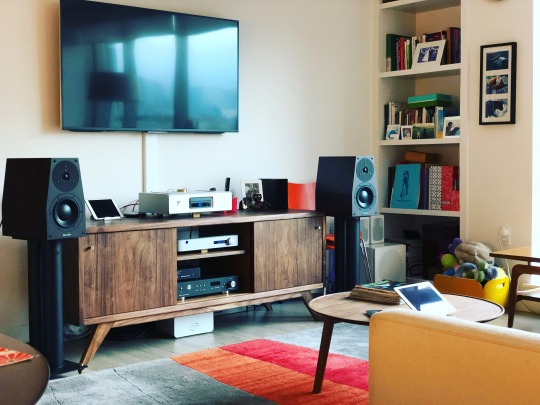
It's been said speakers mirror the personality of their designers, and if you've met the talented and affable Alan Yun no doubt you’ll feel his influence. Much like the man behind it, the SR17 Supreme is sharp, earnest and engaging, yet easy-going, with an unforced warmth and great attention to detail. There’s something grounded and unfussy about the way it allows music to flow forth, feeling like it's taken an expressive limiter off of a recording without hyping it in any way. It checks off many of the audiophile boxes too - imaging, tonal balance, bass power and extension, etc. etc. - but focusing on those mechanical aspects, as excellent as they are, would be selling Alan’s accomplishment short. The SR17 Supreme is first and foremost a faithful and thoroughly enjoyable reproducer of music, one capable of strongly evoking the beauty of the original musical event. There are countless 2-way monitors superficially like this one, but few that I know that are so meticulously and lovingly tuned to such great effect.
I've spent a lot of words espousing this speaker, but I think it's deserving of it, not just because of the obvious quality of the product, but because Silverline is a small manufacturer flying under the radar without a big dealer network or advertising budget. While Alan continues to develop his entry-level Minuet and Prelude lines at a more rapid pace to keep up with market demands, he doesn’t pen up new versions of his reference models every couple years to generate hype. He’s instead chosen his design fundamentals wisely and focused on perfecting their execution through years of painstaking refinement, much as the late Bobby Palkovic @ Merlin Music did. Like Bobby, he has a great ear for music, does a lot of the production work himself, and gains most of his sales through word of mouth. This does make it trickier to find than the big brands at a typical shop, but I strongly encourage seeking out an opportunity to hear it. The SR17 Supreme is a special speaker, and it won't be leaving my living room any time soon.
Silverline Audio
P.O. Box 30574
Walnut Creek, CA 94598
USA
3 notes
·
View notes